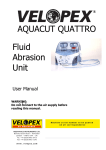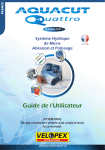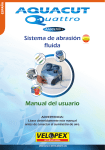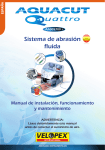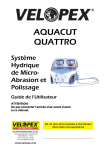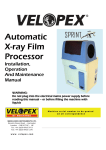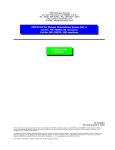Download Fluid Abrasion Unit USER MANUAL
Transcript
ENGLISH AA005700 + Fluid Abrasion Unit USER MANUAL WARNING: Do not connect to the air supply before reading this manual. MEDIVANCE INSTRUMENTS LTD • Barretts Green Road • Harlesden • London • NW10 7AP CONTENTS INDICATIONS FOR USE WARNINGS SUGGESTED TREATMENT METHODS FOR AQUACUT QUATTRO PREPARATIONS BEFORE TREATMENT TREATMENTS - CLEANING TREATMENTS - FISSURE CARIES TREATMENT TREATMENTS - CAVITY PREPARATION TREATMENTS - REMOVAL OF COMPOSITE RESTORATIONS TREATMENTS - BONDING ORTHODONTIC BRACKETS PAGE 3 3 4 5 6 7 8 9 9 Aquacut Quattro INDICATIONS FOR USE Preparation of Pit and Fissure for Sealants Removal of Composites for Restoration Cavity Preparation Cleaning, Polishing and Stain Removal Etching WARNINGS ONLY QUALIFIED DENTISTS SHOULD USE THE AQUACUT QUATTRO ON PATIENTS AFTER READING THIS MANUAL AND THE AQUACUT QUATTRO INSTALLATION, OPERATION AND MAINTENANCE MANUAL, IN PARTICULAR THE SECTION HEADED – `THE FIRST STEPS TO MASTERING THE AQUACUT QUATTRO’. SPECIAL CONSIDERATION MUST BE GIVEN TO THE USE OF THE AQUACUT QUATTRO ON PATIENTS WHO HAVE: 1) RESPIRATORY DIFFICULTIES, 2) ASTHMA, 3) A COLD, 4) BLOCKED NASAL PASSAGES, 5) RESTRICTED SODIUM DIET 6) ANY OTHER MEDICAL PROBLEM THAT MAY PREVENT THE PATIENT FROM BREATHING THROUGH THE NOSE. ANY PATIENT SUFFERING FROM ANY OF THE ABOVE CONDITIONS SHOULD CONSULT THEIR PHYSICIAN BEFORE HAVING TREATMENT WITH AQUACUT QUATTRO. AQUACUT QUATTRO MAY CAUSE SOFT TISSUE DAMAGE, INCLUDING INFLAMMATION AND BLEEDING, AND CREATION OF AN AIR EMBOLISM. THEREFORE ALWAYS USE TOWARDS INCISAL EDGE OF THE TOOTH. BE AWARE THAT IF INCORRECTLY USED THE AQUACUT QUATTRO CAN CAUSE HARD TISSUE DAMAGE INCLUDING ETCHING OR ABRASION OF ENAMEL OR EXPOSED ROOT SURFACES OF THE TEETH. HANDPIECES MUST BE STERILISED BEFORE FIRST USE AND BETWEEN PATIENT TREATMENTS. REFER TO THE INSTALLATION, OPERATION AND MAINTENANCE MANUAL. DISPOSABLE FEEDLINE AND TIPS ARE FOR ONE TIME USE ONLY. ALWAYS USE A NEW FEEDLINE AND TIP WITH EACH PATIENT. DO NOT TURN ON THE AIR SUPPLY UNTIL YOU HAVE READ THE COMPLETE USER MANUAL AND INSTALLATION, OPERATION AND MAINTENANCE MANUAL. ALL POWDERS SUPPLIED BY MEDIVANCE ARE STERILE WHEN PACKED AND THE POWDER CONTAINERS ARE NOT REUSABLE. USE ONLY ORIGINAL MEDIVANCE CONSUMABLE PRODUCTS (POWDERS ETC), AS OTHER MAKES MAY DAMAGE OR ALTER THE PERFORMANCE OF THE AQUACUT QUATTRO AND MAKE THE MACHINE DANGEROUS. ALWAYS ENSURE SAFETY GOGGLES & MASKS ARE WORN BY EVERYONE IN THE AREA WHEN SETTING UP OR USING THIS EQUIPMENT. ALWAYS ENSURE THE HANDPIECE IS UNDER CONTROL AND THE NOZZLE IS POINTING IN A SAFE DIRECTION. Aquacut Quattro SUGGESTED TREATMENT METHODS FOR AQUACUT QUATTRO The British Dentist, Dr Raghuvir Patel is principal of a general dental practice in Essex and has been a vocational trainer for the last 10 years. He is a keen advocate and user of the fluid abrasion technique. Dr Patel, who also lectures on the subject, has established that fluid abrasion can be used successfully in a variety of tooth preparations. Dr Patel has prepared the following pages that outline these procedures, which are all based on his considerable experience with a wide variety of Air Abrasion Products. Please note that the following methods of treatment are advisory. Each dentist will quickly develop a preference for the settings of the air pressure, abrasive powder and fluid flow, as well as variables such as the abrasive powder type and the cutting angle of the nozzle. For set-up and control of cutting fluid, refer to the installation operation and maintenance manual. Every user will soon find the most convenient setting for each of the treatment techniques. Note that the tip of the cutting nozzle should be held approximately 1.5mm from the surface being worked on. Also, avoid holding the cutting nozzle square to the perpendicular being worked on as this will cause the abrasive particles to blur the view of the working area and also reduce the cutting efficiency. Angle the cutting tip towards the aspirator. Instruct the Dental Assistant to follow the Aquacut Quattro tip with the Aspirator. It has been found that dentists quickly adapt to Aquacut Quattro and it is liked by both dentists and patients because of the low noise, and the lack of vibration and heat. Its ability to cut wet and dry increases its flexibility of use. Generally there is no need to give a local anaesthetic as fluid abrasion is, in most cases, quite painless, however – always offer anaesthetic to nervous patients. NOTE: The following pages give a range of settings for each procedure. Start at the lower end of the recommended settings and work up as you become more proficient Increasing the air pressure or the abrasive powder flow will increase the cutting speed or cleaning rate and, conversely, decreasing either of the settings will decrease the cutting speed or cleaning rate. If the air pressure is increased but the abrasive powder flow decreased, then the cutting speed will remain substantially the same but with less powder out-flow from the working area. If the air pressure is decreased but the abrasive powder flow Increased, then the cutting speed will remain substantially the same but the patient will be subjected to a less aggressive treatment which is ideal for use on sensitive areas. Aquacut Quattro PREPARATIONS BEFORE TREATMENT WARNING: - BEFORE OPERATING WITH AQUACUT, THE PERSON OPERATING THE UNIT, ANY ASSISTANTS, THE PATIENT AND ANYONE ELSE IN THE OPERATING AREA MUST WEAR EYE PROTECTION TO BS EN 166 IF 415 AND EXCEPT FOR THE PATIENT THEY MUST ALL WEAR RESPIRATORY MASKS TO EN 149 FFP2S. 1. It is recommended that a light coating of petroleum jelly is smeared around the patient’s lips to prevent cracking and to attract some of the out-flow of abrasive powder. 2. Rubber dam should be used to protect adjacent teeth and soft tissue. Metal Matrix bands should be used to protect adjacent teeth during interproximal preparations. A Bib should be used to protect a patient’s clothes from any out-flow of the material from the mouth during the course of a treatment. 3. USE A HIGH SPEED INTRA-ORAL ASPIRATOR PREFERABLY WITH A FLARED TIP. 4. An extra-oral evacuator can also be used with the extraction cone sited below the patient’s chin. 5. Important: When switching chambers from Aluminium Oxide (for cutting), to Sodium Bicarbonate (for cleaning), it is important to clear the air lines of any residual cutting powder. To achieve this, simply switch over to the required chamber, Aim the handpiece nozzle into the aspirator and operate the machine foot pedal ‘CUT’ position for 10 seconds minimum. This will purge the lines of any previously used powder. 6. Only Aquacut Quattro Fluid should be used in the Aquacut Quattro Fluid System. The 500ml bottles supplied with the machine should be discarded when empty. The fluid can be used with all recommended treatments using this instrument. Aquacut Quattro TREATMENTS CLEANING. Settings: - Powder - Cutting Nozzle - Cutting Speed - Powder Flow - Sodium Bicarbonate (clear container). 0.6mm diameter or 0.8mm diameter. 3Bar to 5Bar 1 This treatment is particularly easy when using the AQUACUT QUATTRO and gives a superior finish to the teeth. Where the teeth have been stained by coffee and/or smoking, fluid abrasion comes into its own. The fine particles of sodium bicarbonate penetrate the micro crevasses of the tooth surface and the particulate beam easily follows the contours of the tooth surface, enabling the staining to be removed very quickly and with no discomfort to the patient. The settings as listed above will create a wide particulate beam of high velocity and medium particulate density. This is to prevent removal of the tooth enamel yet provide sufficient power to remove staining. The cutting nozzle should be held approximately 4mm from the surface of the tooth at an angle of approximately 45 Deg. By moving the nozzle further away from the surface of the tooth, the rate of removal of staining can be slowed down. Move the handpiece slowly over the tooth surface. The most effective way to use fluid abrasion for this procedure is to use the handpiece of the AQUACUT as if it were a paintbrush, making light strokes across the surface of the tooth until the surface is clean. With experience, the dentist will be able to work with a high degree of control, the learning curve being similar to that when first using a high speed drill. Aquacut Quattro TREATMENTS FISSURE CARIES TREATMENT. Settings: - Powder - Cutting Nozzle - Cutting Speed - Powder Flow - 29micron Aluminium Oxide (blue container). 0.5mm diameter or 0.6mm diameter. 3Bar 1 The AQUACUT QUATTRO is of particular use for treating fissure caries. To treat the caries, use the Settings as listed above. Hold the cutting nozzle about 2mm from the surface of the tooth and direct the particulate beam at the caries. Use it in short bursts sweeping it along the vein until all the dark caries is removed and the sound tooth structure is revealed. The beauty of this procedure is its speed and the absolute control possible, ensuring that the minimum amount of tooth structure is removed. The newly prepared surface, being dry and abraded, is now ready for restorative materials. Normally local anaesthetic is not necessary for the above treatment. NOTE: If there is soft caries present in the dentine, a rotary instrument may have to be used, or use the Sodium Bicarbonate on ‘cleaning’ setting. This is because soft and moist caries are resilient and therefore not so effectively removed by the use of fluid abrasion. Aquacut Quattro TREATMENTS CAVITY PREPARATION. Settings: - Powder - Cutting Nozzle - Cutting Speed - Powder Flow - 53micron Aluminium Oxide (red container). 0.6mm diameter or 0.8mm diameter. 4Bar to 6Bar 3 to 5 The procedure for the preparation of a cavity with the AQUACUT QUATTRO will depend on the size of the cavity and the extent and type of caries. For small cavities, the cutting nozzle should be held at an angle of between 35 Deg and 45 Deg to the surface being abraded and about 2mm or 3mm from the surface. The best approach is to use a slow circular motion over the affected area until sound tooth structure is revealed. The tooth is now ready to be filled in the normal way. For larger cavities, a combination of the AQUACUT QUATTRO and a rotary instrument may be of benefit. This is because fluid abrasion is a technique designed to produce a very conservative cut with a working area of less than 2mm diameter. Finally, the surface of the cavity should then be finished using the AQUACUT QUATTRO to ensure a suitable key for the bonding agent. NOTE: Fluid abrasion is not a suitable technique for shaping undercuts for amalgam restorations. Traditional rotary instruments should be used for this application. Aquacut Quattro TREATMENTS REMOVAL OF COMPOSITE RESTORATIONS. Settings: - Powder - Cutting Nozzle - Cutting Speed - Powder Flow - 53micron Aluminium Oxide (red container). 0.6mm diameter or 0.8mm diameter. 4Bar to 6Bar 3 to 5 The AQUACUT QUATTRO is very useful for the removal of old composite restorations. Hold the cutting nozzle at an angle of about 45 Deg to the surface of the old composite restoration and about 2mm or 3mm from the surface. The best approach is to use a slow circular motion over the old restoration beginning at the edge, particularly at the failed margin, until all the old composite has been removed and the cavity preparation completed. The new restorative can now be applied in the normal manner without any further treatment. Follow the manufacturer’s recommendations with regard to the use of acid etch with bonding systems. Aquacut Quattro TREATMENTS BONDING ORTHODONTIC BRACKETS. Settings: - Powder - Cutting Nozzle - Cutting Speed - Powder Flow - 29 or 53micron Aluminium Oxide (red container). 0.6mm diameter or 0.8mm diameter. 4Bar 1 The enamel of the tooth to be treated can be “etched” to the exact size of the orthodontic bracket at the place of attachment. This is achieved by holding the cutting nozzle 2mm above the surface of the tooth and gently moving it in a circular motion over the required area. This will result in a dry “etched” surface, ready to accept the bonding agent, and the risk of saliva contamination is greatly reduced because the aluminium oxide dries the surrounding mucosa. The same technique can be used to clean the orthodontic brackets. 10 Aquacut Quattro NOTES Aquacut Quattro 11 ENGLISH AA005700 + Fluid Abrasion Unit WARNING: Do not connect to the air supply before reading this manual. Medivance – Aquacut Quattro User Manual Velopex is a trademark of Medivance Instruments Ltd Pt No I/LIT Date 0011P 20.08.08 Issue 4 www.velopex.com Aquacut Tel: +44 (0)20 8965 2913 Fax: +44 (0)20 8963 1270 12 Quattro












